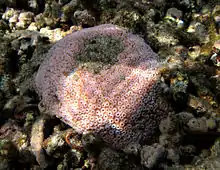Astreopora listeri
Astreopora listeri is a species of hard coral found in shallow water in the tropical Indian and Pacific Oceans. It is an uncommon species with a wide range and is tolerant of turbid water, making it more resilient than some other corals to habitat disturbance. The International Union for Conservation of Nature has assessed its conservation status as being of "least concern".[1]
| Astreopora listeri | |
|---|---|
 | |
| Scientific classification | |
| Kingdom: | Animalia |
| Phylum: | Cnidaria |
| Class: | Anthozoa |
| Order: | Scleractinia |
| Family: | Acroporidae |
| Genus: | Astreopora |
| Species: | A. listeri |
| Binomial name | |
| Astreopora listeri Bernard, 1896[2] | |
| Synonyms | |
| |
Description
Astreopora listeri may form hemispherical mounds or flattened and partially encrusting colonies. The corallites are crowded and not arranged in any particular pattern. They are immersed and have small circular openings surrounded by delicate feathery spinules, giving the colony a rough surface. This coral resembles Astreopora myriophthalma and Astreopora randalli in appearance and is usually cream, pale brown or grey.[3]
Distribution and habitat
Astreopora listeri is widely distributed in the tropical Indo-Pacific region. Its range extends from Madagascar and East Africa to Indonesia and eastern Australia. It is found in several different types of shallow water reef habitat including turbid areas,[3] at depths between 5 and 20 m (16 and 66 ft).[1]
Ecology
Astreopora listeri is a zooxanthellate species of coral,[4] harbouring symbiotic dinoflagellates which provide their host with the products of photosynthesis.[5] This coral is sometimes host to the bio-eroding demosponge Cliona orientalis which attacks various calcareous substrates including corals and weakens their structure.[6]
Status
The greatest threats faced by corals are loss of habitat and global climate change. The specific threats faced by this species are unknown, but the genus is susceptible to bleaching and coral diseases. However, this is a widespread species, with a presumed large total population which is tolerant of turbid conditions, and the International Union for Conservation of Nature has assessed its conservation status as being of "least concern".[1]
References
- Richards, Z.T.; Delbeek, J.T.; Lovell, E.R.; Bass, D.; Aeby, G.; Reboton, C. (2014). "Astreopora listeri". IUCN Red List of Threatened Species. 2014. Retrieved 17 September 2018.CS1 maint: ref=harv (link)
- Hoeksema, Bert (2018). "Astreopora listeri Bernard, 1896". WoRMS. World Register of Marine Species. Retrieved 17 September 2018.
- " Astreopora listeri Bernard, 1896". Coral fact sheets. AIMS. 2013. Retrieved 18 September 2018.
- Cairns, S.D.; Hoeksema, Bert; Van der Land, Jacob (1999). "List of extant stony corals". Atoll Research Bulletin. Retrieved 18 September 2018.
- Ruppert, Edward E.; Fox, Richard, S.; Barnes, Robert D. (2004). Invertebrate Zoology, 7th edition. Cengage Learning. p. 122. ISBN 978-81-315-0104-7.
- Schönberg, Christine H. L. (2002). "Substrate Effects on the Bioeroding Demosponge Cliona orientalis 1. Bioerosion Rates". Marine Ecology. 23 (4): 313–326. doi:10.1046/j.1439-0485.2002.02811.x.
